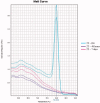Usefulness of a 16S rDNA real-time PCR to monitor neonatal sepsis and to assist in medical decision to discontinue antibiotics
- PMID: 26334172
- PMCID: PMC4841028
- DOI: 10.3109/14767058.2015.1077223
Usefulness of a 16S rDNA real-time PCR to monitor neonatal sepsis and to assist in medical decision to discontinue antibiotics
Abstract
Objective: To monitor the bacterial load in newborns with proven infections on the day of admission, 48 h and 7 days after treatment.
Methods: Real-time PCR (qPCR) targeting the 16S rDNA.
Results: The study recruited 17 newborns and the bacterial load was in general low (<50 CFU/mL). In three of four deaths, the bacterial load values increased, and in 11 of the 13 survivors the values decreased until the third evaluation.
Conclusion: Considering the extreme sensitivity and high negative predictive value of qPCR, this test could help to monitor the treatment of neonatal sepsis and to assist in medical decision to discontinue antibiotics.
Keywords: 16S rDNA; Bacterial load; neonatal sepsis; quantitative PCR; real time PCR.
Figures

References
-
- Liu L, Johnson HL, Cousens S, et al. Global, regional, and national causes of child mortality: an updated systematic analysis for 2010 with time trends since 2000. Lancet. 2012;379:2151–61. - PubMed
-
- Pammi M, Flores A, Leeflang M, Versalovic J. Molecular assays in the diagnosis of neonatal sepsis: a systematic review and meta-analysis. Pediatrics. 2011;128:e973–85. - PubMed
-
- Ohlin A, Bäckman A, Ewald U, et al. Diagnosis of neonatal sepsis by broad-range 16S real-time polymerase chain reaction. Neonatology. 2012;101:241–6. - PubMed
-
- Rogers GB, Stressmann FA, Koller G, et al. Assessing the diagnostic importance of nonviable bacterial cells in respiratory infections. Diagn Microbiol Infect Dis. 2008;62:133–41. - PubMed
Publication types
MeSH terms
Substances
LinkOut - more resources
Full Text Sources
Other Literature Sources
Medical
